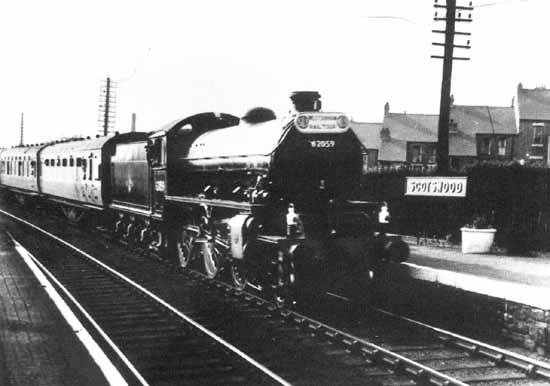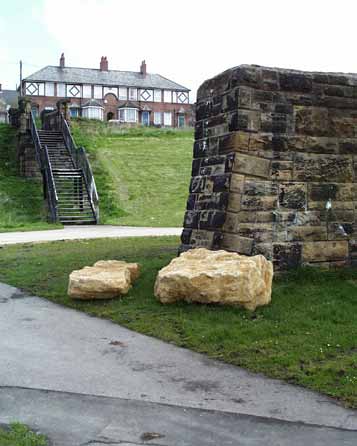|
Scotswood
Road
Sat. 28th April, 2001
|
 |
 |
|
The western riverside route from the city to Lemington and Newburn is Scotswood Road. For 2.25 km (1.6 mi) the
Elswick and Scotswood factories of W.G. Armstrong and Whitworth stretched along the banks of the Tyne.
Up the valley
slope, beyond the road ran the North Eastern Railway main east-west line. This rail link served the factories here and beyond at Lemington and Newburn.
Here the remnants of the rail line, removed in
the late 1980s, are visible with the housing beyond. |
|
|
|
|
©1970 Professor Norman McCord, University of Newcastle upon Tyne, United Kingdom. |
|
This 1970 aerial view of South Benwell shows the plan. The edge of the factory is at the bottom of the frame, above that the
railway; with Elswick station in the middle. Then Scotswood Road runs from right to left, with its ribbon of pubs and newsagent shops, then the housing starts beyond this. Further to the left of this photograph the road
and the railway swap over at Paradise bridge. The rail station is the site of regeneration today. |
|
 |
 |
|
The factory, pubs and railway have all gone, and those rows of Tyneside houses were cleared away during the early 1970s. The
housing that replaced this older 1880s stock lasted for a mere 20 years before it was torn apart by local tearaways and drug crazed youths. The land is now to be used for light industrial and office accommodation. That
entrance on the left of the road is opposite the location of the old railway station. The land in the foreground was the site of the "Hydraulic Crane" public house, that extolled the marvels of the huge barge loading
device seen below.
After the fighting frenzy of the First World War, Armstrong's factory turned to railway engine manufacture. These locos, seen in 1921, are destined for the East India Railway Company. The 1831
Scotswood Chain Bridge can be seen in the background. |
|
©1990 West Newcastle Local Studies Group, Newcastle upon Tyne, United Kingdom. |
|
Five years earlier this 12 inch howitzer was loaded onto its rail bogie for transport to the front in France. During the war
78,000 people worked in this factory, 21,000 of whom were women. They produced a staggering 13,000 guns, 12,000 gun carriages, 18 million ammo rounds, 47 warships, 62 armed warships 230 armed merchant ships, two train
ferries, a floating crane, and 102 tanks. |
|
©1990 West Newcastle Local Studies Group, Newcastle upon Tyne, United Kingdom. |
|
This is the site of the railway station and that big gun today. The tall modern buildings and car parks of the Armstrong Business
Park are visible. This 1990s white collar office development was thrown up in Development Area status land to compensate for the loss of jobs caused by the Tory political decision to allow foreign competitors to take
the heavy industrial capacity and forcibly forbid the previous UK players in this market from participating. Similar dereliction can be seen on the Gateshead side of the river. Below is Scotswood railway station on 29th
April 1967. |
|
©1967 Mr. P. Bailey, Newcastle upon Tyne, United Kingdom. |
 |
|
That roundabout is at the foot of Atkinson Bank and is the site of the Paradise Bridge. This was part of the 1839
railway from Carlisle to Newcastle. The trains travelled on an embankment to the left of this east facing view.
The right side of the dual carriageway is its original route, and it performed a severe
"S" bend to go under the bridge. Those parked cars on the right mark the entrance to the Corporation rubbish destructor, built over 100 years ago.
From here to Scotswood Bridge approach the remnants
of the armament works are now occupied by a motor car showroom the size of a small airport, a massive plumbers' merchant, a bearings factory, a haulage distribution centre, and the Vickers Tank factory.
|
|
|
|
|
 |
 |
|
The western view from this point is rather bland today. A decade or so ago it was bustling with commercial and
industrial activity. The railway ran on that embankment to the right, and that space bounded by the grey wall was the depot for Reed's Cranes.
In the distance on the left is the white Vickers sign
that denotes the end of the factory and the approach to the new Scotswood Bridge.
Beyond the embankment the edge of Scotswood housing is visible. This estate was built in the 1920s to augment earlier
developments further up the bank. |
|
|
Although constructed to a traditional design, these were cheerful and spacious homes when compared with the Tyneside
flats nearby.
The housing in the centre of the estate was subject to urban decay and damage during the 1980s and the city Council decided to bulldoze the heart out of the community.
Residents
were moved to nearby Slatyford, Benwell, and West Denton.
This area has had its social problems since its inception. Without underlying economic prosperity and a route to a better life the spacious
housing alone could not solve the fundamental human malaise. |
|
 |
|
From the edge of the housing the multi track railway has now been replaced by that cycle track. Betwen the tracks and
the steep bank down to the road was a area of derelict land strewn with building rubble and rubbish.
Called locally "The Tank" it was the scene of an infamous murder in 1968. A nine year old girl called Mary Bell killed a smaller boy called Brian Howe. She had previously killed Martin Brown in an empty house.
The full horror came out at the trial at Moot Hall assizes,
and Mary was incarcerated for 12 years. Although free now and living in Suffolk, she is still a pathological and unreformed killer. |
|
|
|
|
 |
 |
|
Vickers Defence Systems tank factory is now just a tiny part of the previous enterprise. The economic activity
generated here, although for warfare and the production of killing machines, not only made a fortune for Lord Armstrong, but the whole city benefited from his generosity.
Without this activity we
would not have Jesmond Dene, Heaton Park, and education in the city would have been the poorer by many millions.
It is doubtful that this level of enterprise and human employment will return in our
lifetimes. It would be foolish to pretend that we can wave a magic wand and restore the wealth; and return to the outrageous inequalities that were created at the same time. |
|
 |
 |
|
Site and contents (unless otherwise stated) © Tim. Pickford-Jones and Timmonet, Newcastle upon Tyne,
United Kingdom. |
|
 |
|
|
 |
|
If you should arrive here via a search, or be missing the navigation on the left hand side, click this button.
|
|












